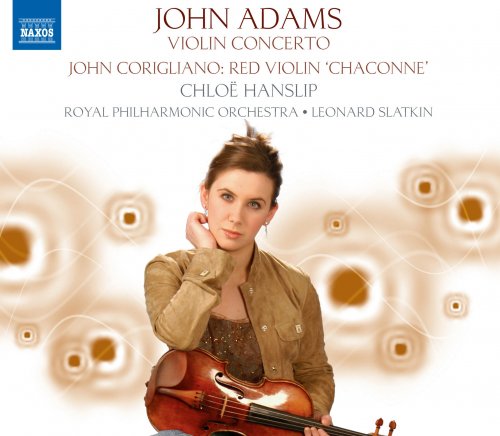
Chloë Hanslip - John Adams: Violin Concerto, John Corigliano: The Red Violin "Chaconne" (2006)
BAND/ARTIST: Chloë Hanslip
- Title: John Adams: Violin Concerto, John Corigliano: The Red Violin "Chaconne"
- Year Of Release: 2006
- Label: Naxos
- Genre: Classical
- Quality: FLAC (tracks)
- Total Time: 01:03:46
- Total Size: 305 mb
- WebSite: Album Preview
Tracklist:
The Red Violin
1. Chaconne for Violin & Orchestra 16:48
2. Romanian Rhapsodies, Op. 11
2 No. 1 in A Major (Arr. F. Waxman) 02:26
Tristan & Isolde Fantasia (Franz Waxman)
3. Tristan & Isolde Fantasia 11:02
Violin Concerto (John Adams)
4. I. Quarter note = 78 15:19
5. II. Chaconne (Body Through Which the Dream Flows) 10:49
6. III. Toccare 07:22
Performers:
Violin – Chloë Hanslip
Royal Philharmonic Orchestra
Conductor – Leonard Slatkin
The Red Violin
1. Chaconne for Violin & Orchestra 16:48
2. Romanian Rhapsodies, Op. 11
2 No. 1 in A Major (Arr. F. Waxman) 02:26
Tristan & Isolde Fantasia (Franz Waxman)
3. Tristan & Isolde Fantasia 11:02
Violin Concerto (John Adams)
4. I. Quarter note = 78 15:19
5. II. Chaconne (Body Through Which the Dream Flows) 10:49
6. III. Toccare 07:22
Performers:
Violin – Chloë Hanslip
Royal Philharmonic Orchestra
Conductor – Leonard Slatkin
This is an unusually sumptuous release for the Naxos label, with a fully designed sleeve bearing a sharp picture of young British soloist Chloë Hanslip placed over the usual Naxos template cover. The enhanced presentation is understandable, for the program is an unusually ambitious one -- it attempts to present an entirely fresh and crowd-pleasing group of American works for violin and orchestra, all composed in the twentieth century. And, as it turns out, the program is successful. Its outer works both make use of the chaconne principle, the repeating ground bass pattern that was one of the organizing devices of Baroque music. The Chaconne from The Red Violin by John Corigliano was abstracted by the composer from his score for that film in a novel way: he selected themes from the film and fit them to the ground bass. As such, the work presents a contrast between lush variety in its violin part (and other melodic parts) and its spare underpinning, way in the low background. The second movement of John Adams' Violin Concerto is also a chaconne, but of a more minimalist kind; Adams varies the pattern subtly, using bells and other percussion in what must be counted as one of his most alluring pieces. The whole concerto hangs together; the first movement is not a chaconne, but it is built on a repeating figure in the orchestra that slowly gains in intensity in a way characteristic of Adams; conceptually, it fits with the chaconne idea, as does the vigorous "Toccare" finale. Two works by film composer Franz Waxman constitute a little entr'acte, and they fit with the creative adaptation idea of the Corigliano: his arrangement of Enescu's Romanian Rhapsody No. 1 is a radical compression of that work down to under two and a half minutes, while the Tristan and Isolde Fantasia, somewhat longer, is likewise quite a speed-read version of its model, with a unique piano part. Hanslip is a fine developing soloist who attacks the music with gusto and lacks only an electric presence at the top of her range to reach marquee-star status, and conductor Leonard Slatkin is in his element with all of this music, successfully molding the Royal Philharmonic Orchestra into a group capable of handling anything from Waxman's high-calorie Austro-Hungarian romanticism to the bracing strains of Adams. The Abbey Road Studios sound is fine, and in all this is an experiment that has succeeded and is likely to attract attempts at replication.
As a ISRA.CLOUD's PREMIUM member you will have the following benefits:
- Unlimited high speed downloads
- Download directly without waiting time
- Unlimited parallel downloads
- Support for download accelerators
- No advertising
- Resume broken downloads


